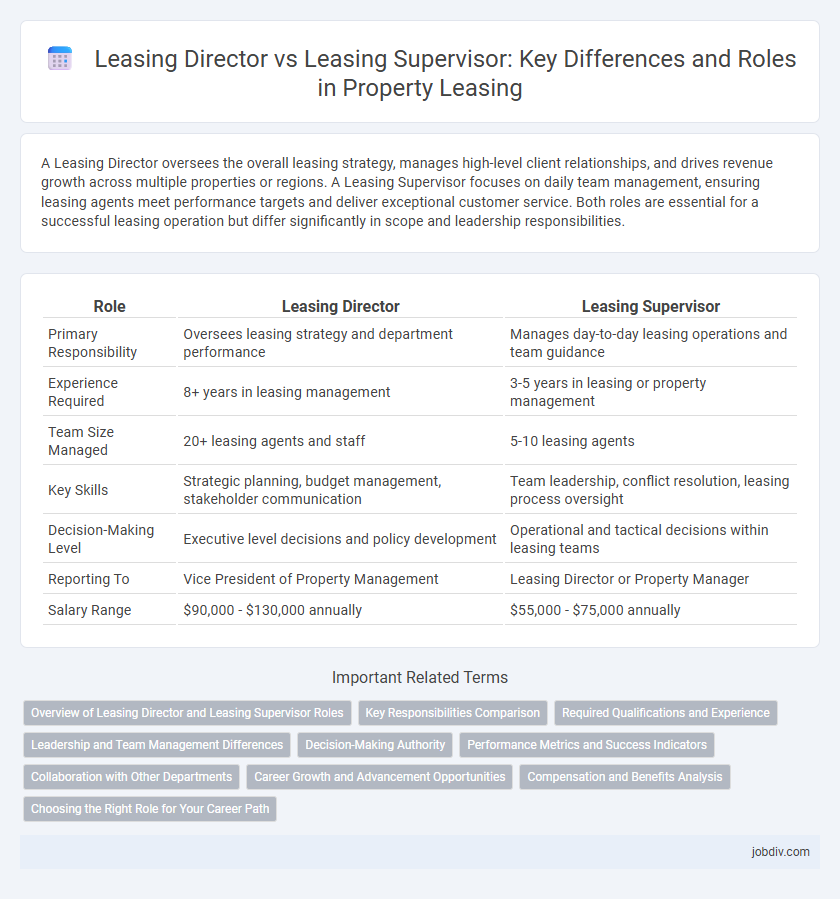A Leasing Director oversees the overall leasing strategy, manages high-level client relationships, and drives revenue growth across multiple properties or regions. A Leasing Supervisor focuses on daily team management, ensuring leasing agents meet performance targets and deliver exceptional customer service. Both roles are essential for a successful leasing operation but differ significantly in scope and leadership responsibilities.
Table of Comparison
| Role | Leasing Director | Leasing Supervisor |
|---|---|---|
| Primary Responsibility | Oversees leasing strategy and department performance | Manages day-to-day leasing operations and team guidance |
| Experience Required | 8+ years in leasing management | 3-5 years in leasing or property management |
| Team Size Managed | 20+ leasing agents and staff | 5-10 leasing agents |
| Key Skills | Strategic planning, budget management, stakeholder communication | Team leadership, conflict resolution, leasing process oversight |
| Decision-Making Level | Executive level decisions and policy development | Operational and tactical decisions within leasing teams |
| Reporting To | Vice President of Property Management | Leasing Director or Property Manager |
| Salary Range | $90,000 - $130,000 annually | $55,000 - $75,000 annually |
Overview of Leasing Director and Leasing Supervisor Roles
Leasing Directors oversee strategic planning, team leadership, and high-level client relations to drive property leasing performance, focusing on maximizing occupancy and revenue growth. Leasing Supervisors manage daily leasing operations, supervise leasing agents, and ensure lease compliance, optimizing tenant retention and operational efficiency. Both roles are critical for successful property management but differ in scope, with Directors focusing on strategic oversight and Supervisors on tactical execution.
Key Responsibilities Comparison
Leasing Directors oversee the strategic planning, development, and execution of leasing operations, managing large teams and ensuring alignment with corporate goals. Leasing Supervisors focus on daily operational management, directly supervising leasing agents, handling tenant relations, and ensuring compliance with leasing policies. The director's role centers on high-level decision-making and portfolio growth, while the supervisor emphasizes team leadership and operational efficiency.
Required Qualifications and Experience
A Leasing Director typically requires a bachelor's degree in business administration or real estate, with over 7 years of experience managing leasing operations and developing strategic plans for property portfolios. In contrast, a Leasing Supervisor usually needs 3 to 5 years of hands-on leasing experience and strong team leadership skills, often supported by certifications in property management or real estate. Advanced proficiency in lease negotiation, compliance, and market analysis distinguishes the Leasing Director from the Leasing Supervisor.
Leadership and Team Management Differences
A Leasing Director oversees multiple leasing teams, setting strategic goals and ensuring overall operational efficiency while driving revenue growth, whereas a Leasing Supervisor manages day-to-day activities within a single team, focusing on motivating and guiding leasing agents. Leadership at the director level involves high-level decision-making, budget management, and cross-department collaboration, while supervisors concentrate on performance monitoring, training, and resolving team issues on the ground. Effective team management for directors requires strong vision communication and organizational alignment, whereas supervisors excel in hands-on coaching and direct staff engagement.
Decision-Making Authority
Leasing Directors typically hold higher decision-making authority, overseeing strategic leasing plans, large-scale negotiations, and approving major lease agreements. Leasing Supervisors manage daily leasing operations, guide leasing agents, and implement policies but usually require director approval for significant decisions. The hierarchical structure places the Leasing Director as the primary decision-maker, ensuring alignment with company goals.
Performance Metrics and Success Indicators
Leasing Directors primarily focus on strategic performance metrics such as portfolio-wide occupancy rates, revenue growth, and market share expansion. Leasing Supervisors concentrate on operational success indicators, including individual leasing agent productivity, lease conversion rates, and tenant retention percentages. Both roles require tracking lead response times and customer satisfaction scores to ensure overall leasing effectiveness.
Collaboration with Other Departments
A Leasing Director collaborates closely with marketing, finance, and property management teams to align leasing strategies with overall business objectives, ensuring cohesive operations and maximizing occupancy rates. A Leasing Supervisor works more directly with maintenance and customer service departments to address tenant concerns promptly and maintain high satisfaction levels. Both roles emphasize cross-departmental communication, but the director focuses on strategic partnerships while the supervisor manages day-to-day coordination.
Career Growth and Advancement Opportunities
Leasing Directors typically oversee multiple leasing teams and develop strategic growth plans, offering broader leadership experience and higher earning potential compared to Leasing Supervisors who manage daily operations and staff on a smaller scale. Career advancement for Leasing Supervisors often involves gaining experience in tenant relations and property management before moving into director-level roles. Professionals aiming for Leasing Director positions benefit from strong skills in financial analysis, market trends, and team leadership to drive portfolio growth and company revenue.
Compensation and Benefits Analysis
Leasing Directors typically earn higher salaries than Leasing Supervisors, with median annual compensation ranging from $85,000 to $120,000 compared to $55,000 to $75,000 for supervisors. Compensation packages for Leasing Directors often include performance bonuses, stock options, and enhanced healthcare benefits, reflecting their strategic leadership roles. Leasing Supervisors generally receive standard benefits like health insurance, retirement plans, and limited bonus structures, aligned with their operational and team management responsibilities.
Choosing the Right Role for Your Career Path
Choosing between a Leasing Director and a Leasing Supervisor depends on your career goals and leadership experience. Leasing Directors typically oversee strategic planning, manage larger teams, and focus on organizational growth, while Leasing Supervisors handle daily operations and team management within specific properties. Assessing your skills in leadership, strategic thinking, and operational management will help determine which role aligns best with your professional development and long-term ambitions.
Leasing Director vs Leasing Supervisor Infographic

 jobdiv.com
jobdiv.com